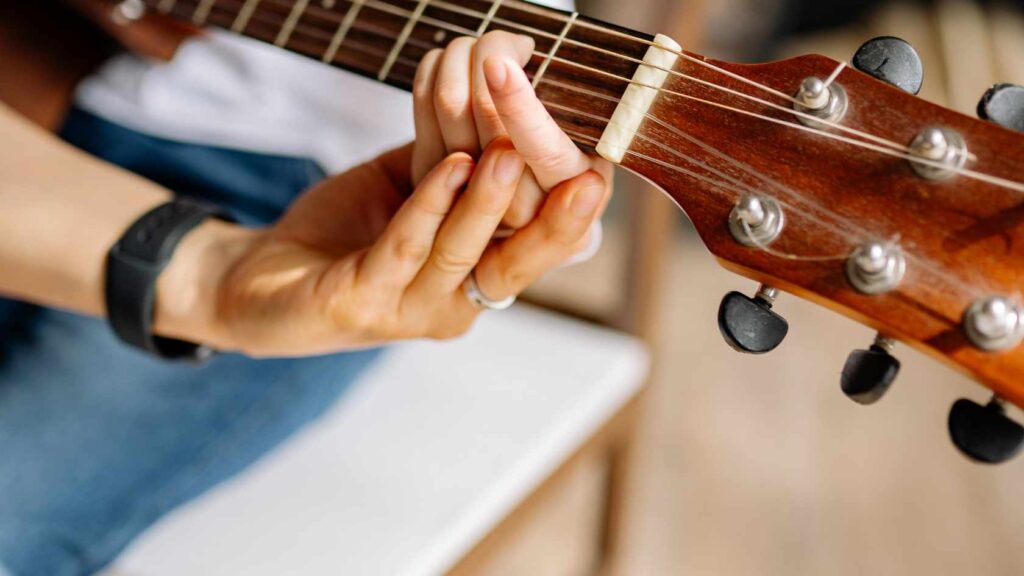This blog is provided by a Lessons In Your Home Teacher

One of the hardest things for any guitarist, regardless of experience level, is settling into a consistent practice routine. Now, consistency does not mean finding one practice routine and never changing it. Change and consistency can go hand and hand during your practices. As guitarists, we have to consistently challenge ourselves to step out of our comfort zones.
The goal is to find exercises that challenge you and then to continue to develop them and challenge yourself as you grow as a guitarist. Below are a few practice techniques that you can grow over time to improve your warm ups. In addition to these techniques, Lessons In Your Home can provide you with knowledgeable guitar lessons and teachers who can also help you along the way. Here are a few you can also do on your own.
The Warm Up (1-2-3-4)
So you’ve sat down, tuned up, and are ready to play. You’re eager to write that next song or maybe master one of your favorite guitarists’ signature solo. Time to jump straight in, right? Not quite. Much like playing a sport, taking a test, or presenting a project, you have to prepare. But this is the practice? That’s right, but it is still critical to warm up for practicing.
A warm up can consist of many things. It will typically be a more repetitive exercise than your actual practice. A common exercise is the 1-2-3-4 practice. Pick 4 different neighboring frets on different strings such as the 1st Fret Low E string, 2nd fret A string, 3rd fret D string, 4th fret G string. Now set your metronome (or metronome app) to a comfortable speed. Begin to play eighth notes. You can start by playing four notes for each fret, then two notes for each fret, and eventually one eighth note per fret. Over time as you get more comfortable you can begin to increase your speed as well as select more challenging frets.
Arpeggios and Scales
A personal favorite of many teachers are arpeggios and scales. An Arpeggio is a series of notes played that make up a larger chord. A scale is the series of notes that sonically match the key signature you are playing in.
The most common scales are the heptatonic Major and Minor scales. They contain seven notes including the octave of the scales tonic note (the first note repeated at a higher pitch for an eight and final step.) For this exercise we will be using a Minor Pentatonic scale. These only contain five notes and an octave. There are a few ways you can tackle this exercise which leads to plenty of variation and growth through the practice. For this example we will talk about the A Minor Pentatonic scale and an A Minor chord.
First you will arpeggiate the A minor chord then continue playing the first position of the A minor Pentatonic scale down and back up. Repeat this process and increase speed as you feel more comfortable, This is a simple, but very effective warm up and practice technique. You can begin to branch out to other positions when you are comfortable. This practice can be applied to multiple chords and scales so you have endless options for letting this technique grow with your abilities.
Turning Songs Into Exercises
This next technique is going to be a good blend of a warm up and possibly a song you’re trying to learn. It combines both previous mentioned techniques, but gives them more difficulty. The first step is to identify a song you’re familiar with and enjoy listening to (this is important because you will be hearing it a lot.) The song needs to have a simple enough, but repetitive guitar part. The repetition in the song is key.
Two great songs to use are “Home” by Edward Sharpe and the Magnetic Zeros or “Don’t Fear the Reaper” by Blue Oyster Cult. Both of these parts are highly repetitive and utilize at least 3 different strings in their repetition. Now after you’ve chosen your song it’s time to learn the part. Again, these parts should be repetitive enough that you can comfortably play them fairly soon. The challenge now is to play them along with a recording of the song. The repetitive nature and added pressure of keeping in time with the recording is a great way to end your warm up before you move onto more difficult areas of your practice.
Contact Us At Lessons In Your Home
We’ve gone through a few different ways to help improve your warm ups and practice sessions, but of course we are always here to help! Our team of dedicated teachers are here to help you with any of your needs on the guitar or any other instrument you may want help with. Reach out to us today!
